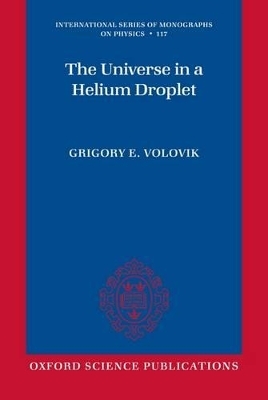
The Universe in a Helium Droplet
Oxford University Press (Verlag)
978-0-19-956484-2 (ISBN)
There are fundamental relations between three vast areas of physics: particle physics, cosmology and condensed matter physics. The fundamental links between the first two areas, in other words, between micro- and macro- worlds, have been well established. There is a unified system of laws governing the scales from subatomic particles to the Cosmos and this principle is widely exploited in the description of the physics of the early Universe. The main goal of this book is to establish and define the connection of these two fields with condensed matter physics.
According to the modern view, elementary particles (electrons, neutrinos, quarks, etc.) are excitations of a more fundamental medium called the quantum vacuum. This is the new 'aether' of the 21st Century. Electromagnetism, gravity, and the fields transferring weak and strong interactions all represent different types of the collective motion of the quantum vacuum. Among the existing condensed matter systems, a quantum liquid called superfluid 3He-A most closely represents the quantum vacuum. Its quasiparticles are very similar to the elementary particles, while the collective modes of the liquid are very similar to electromagnetic and gravitational fields, and the quanta of these collective modes are analogues of photons and gravitons. The fundamental laws of physics, such as the laws of relativity (Lorentz invariance) and gauge invariance, arise when the temperature of the quantum liquid decreases.
This book is written for graduate students and researchers in all areas of physics.
1. Introduction: GUT and anti-GUT ; 2. Gravity ; 3. Microscopic physics of quantum liquids ; 4. Effective theory of superfluidity ; 5. Two-fluid hydrodynamics ; 6. Advantages and drawbacks of effective theory ; 7. Microscopic physics ; 8. Universality classes of fermionic vacua ; 9. Effective quantum electrodynamics in 3He-A ; 10. Phenomenology of superfluid helium-3 ; 11. Momentum-space topology of 2+1 systems ; 12. p-space topology protected by symmetry ; 13. Topology of defects ; 14. Vortices in 3He-B ; 15. Symmetry breaking in 3He-A and singular vortices ; 16. Continuous structures ; 17. Monopoles and boojums ; 18. Anomalous non-conservation of fermionic charge ; 19. Anomalous currents ; 20. Macroscopic parity violating effects ; 21. Quantization of physical parameters ; 22. Edge states and fermion zero modes on soliton ; 23. Fermion zero modes on vortices ; 24. Vortex mass ; 25. Spectral flow in the vortex core ; 26. Landau critical velocity ; 27. Vortex formation by Kelvin-Helmholtz instability ; 28. Vortex formation in ionizing radiation ; 29. Casimir effect and vacuum energy ; 30. Topological defects as source of nontrivial metric ; 31. Vacuum under rotation and spinning strings ; 32. Analogs of event horizon ; 33. Conclusion ; References
| Reihe/Serie | International Series of Monographs on Physics ; 117 |
|---|---|
| Zusatzinfo | 88 line drawings and halftones |
| Verlagsort | Oxford |
| Sprache | englisch |
| Maße | 161 x 232 mm |
| Gewicht | 997 g |
| Themenwelt | Naturwissenschaften ► Physik / Astronomie ► Atom- / Kern- / Molekularphysik |
| Naturwissenschaften ► Physik / Astronomie ► Festkörperphysik | |
| Naturwissenschaften ► Physik / Astronomie ► Hochenergiephysik / Teilchenphysik | |
| ISBN-10 | 0-19-956484-1 / 0199564841 |
| ISBN-13 | 978-0-19-956484-2 / 9780199564842 |
| Zustand | Neuware |
| Haben Sie eine Frage zum Produkt? |
aus dem Bereich


